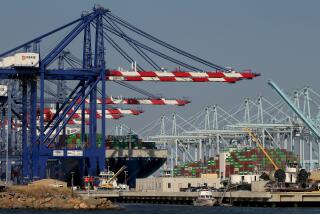Muscled Out : Women Dockworkers Protest Strength Test
- Share via
To fellow dockworkers, Cheryl Olivas is the Banana Queen, a title bestowed for the many hours she has toiled at one of the most physically demanding jobs on the waterfront--slinging 40-pound boxes of bananas from the hatches of ships.
“You just do it all day long, usually one hour on and one off,” said the 34-year-old Olivas, a mother of two young children who has worked as a part-time longshoreman for 2 1/2 years. “After a while, your muscles just burn.”
Now, however, Olivas has been told she cannot unload the bananas--or any other cargo--because she failed a new strength and agility test aimed at decreasing dockworker injuries. Union and employer rules require her to wait 120 days before she can take the test again.
Olivas, 5-4 and 115 pounds, is not optimistic about doing better the second time around.
“I don’t see how any female, unless she is a moose, is going to pass the test the way it is designed,” said Olivas, who describes herself as a “health conscious” person who regularly works out with weights at her Long Beach home.
Olivas, as well as a number of other temporary dockworkers at Los Angeles and Long Beach harbors, has angrily denounced the test, which the International Longshoremen’s and Warehousemen’s Union and the Pacific Maritime Assn., an employers group, jointly began administering to local dockworkers at a union hall in Wilmington on Dec. 8.
The union and the employers association say the test was developed by a private firm after months of study and is fair to all dockworkers. And the National Labor Relations Board has investigated four of eight local complaints about the test and in each case found that it had been instituted properly.
But Olivas and other temporary longshore workers--those laborers called “casuals” who are not registered union members and typically work on a catch-as-catch-can basis during peak periods--say they believe the test is flawed.
Besides being biased against women--almost all women who have taken the test have failed--and older men, the test is discriminatory because registered longshoremen do not have to take it, temporary dockworkers say. New applicants for registration must take it.
Moreover, critics say the short, three-part test, which is designed to test arm and upper-body strength as well as the worker’s sense of equilibrium, is not relevant to many of the jobs they perform on the waterfront.
‘Barnum & Bailey’ Exam
“It’s more like an entrance exam to the Barnum & Bailey Circus,” said Kent Bennett, a 39-year-old dockworker who lives in Long Beach. When interviewed by a reporter several days ago, Bennett said he presumed he passed the test because he was not told otherwise.
“I went out of there huffing and puffing,” Bennett said. “So did a lot of other guys. I saw guys in the parking lot just keeled over in their pickups, exhausted.”
Union officials, who are defending themselves in a pending lawsuit by casuals who allege that the union practiced favoritism in recruiting, say the complaints are an attempt to harass union officials into letting the casuals become registered longshoremen.
Although the 2,500 local casuals sometimes work only a day or two a week with no fringe benefits, fully registered union members are paid well and receive full benefits. More than half of the 7,586 registered West Coast longshoremen who worked 1,600 or more hours last year earned an average of $50,000, according to employer association figures.
‘Lucrative Jobs’
“They think, ‘if we all jump on the bandwagon, we’ll get one of these lucrative jobs,’ ” said one union official, who did not want to be identified.
The union and the employers association also defend their decision not to give the test to registered longshoremen, saying the workers are generally more experienced, are required to take physicals before becoming registered union members and generally have more flexibility in choosing what jobs they want.
In the four cases it investigated, the labor board concluded that the union and employers association acted properly because the test was developed to ensure that there is a qualified work force and was agreed to by both the union and employers, according to James McDermott, an attorney with the National Labor Relations Board in Los Angeles. Although they are not union members, the casuals are represented legally and in negotiations by the union.
McDermott said the four remaining charges are pending.
Nevertheless, some union members, recalling a 1982 federal court order that requires the union to increase the number of women within its ranks to 20% over the next 15 years, expressed concern over the complaints by women that the test is biased against them. They say a handful of temporary women dockworkers at other West Coast ports, where the testing began earlier, have protested the exam, and at least one case involving a Tacoma dockworker is pending before an arbitrator.
Higher Failure Rate
“People are going to say we devised this test to keep women off the docks,” said a union official.
Although both the union and the employers association acknowledge that the failure rate is higher among women than men, they have declined to release the figures, saying not enough casuals have taken the test to make such numbers meaningful.
But union sources say that during the first two weeks of local testing, 260 casuals signed up to take the test. An estimated 95% of the men passed the exam, but of the 14 women who took it, 12 failed.
Chuck Wallace, assistant vice president for the employers association in San Francisco, said the test was instituted because of concerns by the union and employers that some dockworkers were not able to perform some longshore work.
Additionally, the employers and union officials say the tests are part of a broader program aimed at implementing beefed-up safety guidelines along the waterfront and reducing injuries. Casuals also will soon be required to take physicals and drug and alcohol tests, although registered dockworkers have to take only physicals.
Higher Injuries on Docks
In 1985, there were 13.4 incidents per 100 waterfront workers in Southern California where an injury or illness resulted in a lost workday, according to federal Occupational Safety and Health Administration figures.
By comparison, federal statistics show there were 7.6 incidents per 100 workers among the country’s general labor force in 1983, the latest year for which statistics are available.
The test was devised by Advanced Research Resources Organization, a Maryland-based firm that has devised employment tests for a variety of private and public groups, including the entrance exam for FBI special agents.
Deborah Gebhardt, a vice president of the firm, said the company spent more than a year developing the dockworker test, visiting 12 West Coast ports to observe work and interview dockworkers.
Gebhardt said men and women were tested for physical abilities and job performance. That information was used to come up with a single test fair to both men and women who perform “entry level” longshore work, she said. (An example of an entry level job would be unloading bananas.)
Test Called Unfair
Gebhardt, who said men will typically score higher than women on the test, said some women casuals would not seek jobs that were considered tough physically. Casuals can turn down a job and wait for another.
Some casuals argue that since they are allowed to pick their jobs and some require a minimum of physical strength or agility, it is not fair to make them take the test. To a dockworker with a physical ailment and thus only able to take jobs that require operating machinery, the test is tantamount to telling him he cannot work on the waterfront any longer, they say.
But the union and employers association counter that all casuals are expected to do every type of longshore work and the test is designed to ensure that each worker meets minimum physical standards.
Since the testing began 2 1/2 weeks ago, the union says the number of casuals who have voluntarily signed up to take the test has dropped dramatically. A system whereby workers probably will be told to sign up and take the test based on their identification number is in the works, they said, and those who do not take the test after a certain amount of time will not be allowed to work the waterfront.
But one casual who says he has no intention of taking the test is Neal Schreiner, who has frequently butted heads with the union and the employers association over a variety of issues. Although Schreiner says he believes he could pass the test, he said he refuses to do so because it is unfair and unrelated to the work he must perform.
“It’s sort of like a fireman’s test where you have to carry a 300-pound lady out of a burning building,” Schreiner said.
More to Read
Sign up for Essential California
The most important California stories and recommendations in your inbox every morning.
You may occasionally receive promotional content from the Los Angeles Times.












